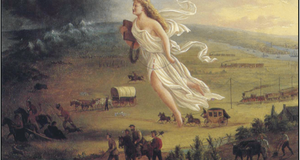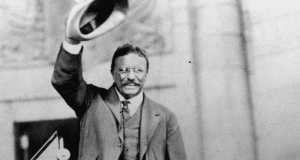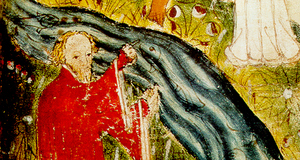Conspiracy: Did FDR Deceive the American People in a Push for War?
By
2010, Vol. 2 No. 01 | pg. 3/3 | « With access to documents from people who were there, it is easy for historians to document this cultural response. According to a diary entry on the day of the attack, Lt. Cornelious C. Smith wrote, “Hell, we could blow them out of the water in three weeks! But here we were with our pants down and the striking force of our Pacific Fleet is settling on the bottom of east Loch, Pearl Harbor. Who wouldn’t be ashamed?”54 There is no doubt the Japanese were seen as inferior. With this attitude by the majority of the American public, a scapegoat was needed so that the people had closure, but to blame to Japanese was out of the question due to their “backwards ways.” Kennedy writes “…could this have happened the only explanation is someone on the American side…these are natural psychological reactions.”55 There are other authors and historians that emphasize the Japanese decision for an act of aggression as to place the blame on the actual aggressors, “The Japanese convinced themselves that necessity and self-protection … to break through real or imagined encirclement and beat off the challenge of any one or combination of their international rivals…”56 This is a classic example of creating a black and white picture of who is the good guy and who is the bad guy. While Japan is viewed as the aggressor, after exposure to the McCollum document, one may think differently.Since the birth of this country, people have been paranoid that their “experiment with freedom” would result in failure, whether through foreign penetration or a conspiracy from the inside.57 Is America so young that it may self-destruct? In America, freedom has always been the ideology which has been defended. But like the many top dictators who suffered paranoia, does America, the top nation, suffer from the same paranoia that everyone is out to sabotage it, including its own government? It is hard to believe that FDR master manipulated an entire country into a war and deliberately withheld vital information. Of course, critics of Roosevelt would use him as a scapegoat. However, people close to him were uncertain as to whether he caused the attack, “Political enemies of Franklin Roosevelt accused him of responsibility for the disaster, even his friends were dismayed.”58 The warning signs in regards to the attack on Pearl Harbor existed yet were vague, and those warnings may have been handled poorly by those involved. The documents Stinnett presents stated that war between the U.S and Japan was inevitable. However no document exists that specifically states that there would be a bombing at Pearl Harbor on the morning of December 7th, 1941. With the pacific fleet stationed in Pearl Harbor it could have been assumed the Japanese had taken full responsibility for the attack, thus invalidating many of the conspiracy theorists accusations and research to date.59 Nonetheless, anti-conspiracy theorist’s retaliations against conspiracy theories have not invalidated the claim of one. The evidence of prior knowledge to the attack is astonishing and believable. A few of the Pearl Harbor files became declassified in the early 1990s and provided evidence supporting the conspiracy. Only when the files become completely declassified in the future will the public know the full truth.60 Without question, Pearl Harbor was the event which lead the U.S into WWII, and there is enough evidence, although circumstantial, to illustrate the United State’s provocation of the Japanese into an act of aggression. FDR’s motives could have not only lead to the deception of the American people, but also lead the United States into WWII through the backdoor of Japan. ReferencesI. Books Gannon, Michael. Pearl Harbor Betrayed: The Story of a Man and Nation Under Attack. New York: Henry Holt and Company, 2001. Olmsted, Kathryn S. Real Enemies: Conspiracy Theories and American Democracy, World War I to 9/11. New York: Oxford University Press, 2009. Prange, Gordon W. At Dawn We Slept: The Untold Story of Pearl Harbor. New York: Penguin Group, 1991. Riebling, Mark. Wedge: From Pearl Harbor to 9/11--How the Secret War between the FBI and CIA Has Endangered National Security. New York: Osprey Productions Inc, 1994. Stinnett, Robert B. Day of Deceit: The Truth About FDR and Pearl Harbor. New York: Touchstone, 2001. Victor, George. The Pearl Harbor Myth: Rethinking the Unthinkable. Virginia: Potomac Books, 2007. Wohlstetter, Roberta. Pearl Harbor: Warning and Decision. Stanford, CA: Stanford University Press, 1962. II. Government Documents U.S Department of the Army. Pearl Harbor Operations: General Outlines of Orders and Plans. Prepared by Military History Section Headquarters, Army Forces Far East. Washington, DC: United States Printing Office, 1945. U.S Department of State. Peace and War United States Foreign Policy 1931-1941. Prepared by the Superintendent of Documents. Washington, DC: United States Government Printing Office, 1943. U.S Senate. Development of Untied States Foreign Policy: Address and Messages of Franklin D. Roosevelt. Complied from Official Sources Intended to Present the Chronological Development of the Foreign Policy of the United States. Washington, DC: United States Printing Office, 1942. III. Video Recordings Conspiracy: FDR and Pearl Harbor (2005). Produced by Baseline Studio Systems. 47 min. A&E Television Networks. DVD. IV. Websites The Independent Institute. "The Truth About Pearl Harbor: A Debate Between Robert Stinnett and Stephan Budiansky." The Independent Institute Online http://www.independent.org (accessed April 13 2009). Endnotes1.) U.S Senate, Development of Untied States Foreign Policy: Address and Messages of Franklin D. Roosevelt, 1942, 77th Cong., 2d sess., House Executive Document 188 (Washington, DC 1942), 125. 2.) Ibid 125. 3.) Ibid 4.) Kathryn S. Olmsted, Real Enemies: Conspiracy Theories and American Democracy, World War I to 9/11 (New York: Oxford University Press, 2009), 45. 5.) Ibid, 52. 6.) Ibid, 42-43. 7.) Conspiracy: FDR and Pearl Harbor, DVD, Produced by Baseline Studio Systems (A&E Television Networks, 2005). 8.) Gordon W. Prange, At Dawn We Slept: The Untold Story of Pearl Harbor (New York: Penguin Group, 1991),2. 9.) Ibid, 2. 10.) Olmsted, 58. 11.) Ibid, 48. 12.) Ibid, 49. 13.) George Victor, The Pearl Harbor Myth: Rethinking the Unthinkable (Virginia: Potomac Books, 2007),3. 14.) Ibid 15.) Conspiracy: FDR and Pearl Harbor. 16.) Victor, 2. 17.) Olmsted, 48. 18.) Ibid, 43. 20.) Ibid, 51. 21.) Ibid 52-54. 22.) Ibid, 55. 23.) Conspiracy: FDR and Pearl Harbor. 24.) Ibid 25.) Robert B. Stinnett, Day of Deceit: The Truth About FDR and Pearl Harbor (New York: Touchstone, 2001), 6. 26.) Ibid 6. 27.) Ibid, 9. 28.) Ibid, 275. 29.) Ibid, 17. 30.) Ibid, 17. 31.) Ibid, 18. 32.) Ibid, 28. 33.) Ibid, 275. 34.) Ibid, 57. 35.) Ibid, 294. 36.) The Independent Institute, "The Truth About Pearl Harbor: A Debate Between Robert Stinnett and Stephan Budiansky," The Independent Institute Online http://www.independent.org (accessed April 13 2009). 37.) Conspiracy: FDR and Pearl Harbor. 38.) Olmsted, 57. 39.) Stinnett, 23. 40.) Ibid, 262. 41.) The Independent Institute. 42.) Stinnett, 23. 43.) Ibid 44.) Olmsted, 58. 45.) Ibid 46.) Olmsted, 57. 47.) Conspiracy: FDR and Pearl Harbor 48.) Prange, 686. 49.) Roberta Wohlstetter, Pearl Harbor: Warning and Decision (Stanford, CA: Stanford University Press, 1962), 172-173. 50.) The Independent Institute. 51.) Conspiracy: FDR and Pearl Harbor. 52.) Ibid 53.) Victor, 3. 54.) Michael Gannon, Pearl Harbor Betrayed: The Story of a Man and Nation Under Attack (New York: Henry Holt and Company, 2001),1. 55.) Ibid 56.) Prange, 2. 57.) Olmsted, 3. 58.) Victor,1. 59.) Conspiracy: FDR and Pearl Harbor. 60.) Ibid Suggested Reading from Inquiries Journal
Inquiries Journal provides undergraduate and graduate students around the world a platform for the wide dissemination of academic work over a range of core disciplines. Representing the work of students from hundreds of institutions around the globe, Inquiries Journal's large database of academic articles is completely free. Learn more | Blog | Submit Latest in History |
















